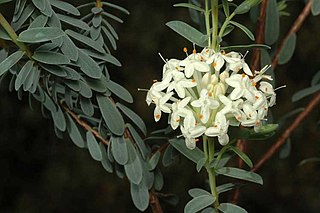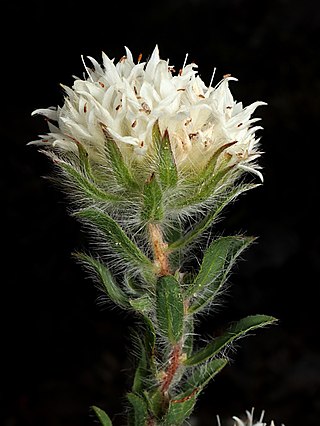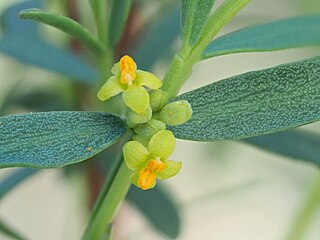
Pimelea microcephala, commonly known as mallee rice-flower or shrubby rice-flower is a species of flowering plant in the family Thymelaeaceae and is endemic to mainland Australia. It is an erect shrub with compact heads of male or female, white to yellow or greenish flowers on separate plants, the heads surrounded by 2 or 4 leaf-like involucral bracts.

Pimelea humilis, also known as common riceflower or dwarf riceflower, is a species of flowering plant in the family Thymelaeaceae and is endemic to south-eastern Australia. It is an erect or scrambling shrub with hairy stems, elliptic to lance-shaped leaves and heads of 12 to 52 of creamy-white, bisexual or female flowers.

Pimelea flava is a species of flowering plant in the family Thymelaeaceae and is endemic to south-eastern Australia. It is a shrub with narrowly elliptic to egg-shaped leaves arranged in opposite pairs, and compact clusters of 9 or more flowers with 2 or 4 elliptic to circular involucral bracts at the base. The flowers and bracts are white or yellow, depending on subspecies.

Pimelea octophylla, commonly known as woolly riceflower or downy riceflower, is a species of flowering plant in the family Thymelaeaceae and is endemic to south-eastern continental Australia. It is an erect shrub with densely hairy young stems, narrowly elliptic leaves and heads of 22 to 45 densely hairy, cream-coloured to pale yellow flowers surrounded by 6 to 12 leaf-like involucral bracts.

Pimelea ciliolaris is a species of flowering plant in the family Thymelaeaceae and is endemic to a restricted area of New South Wales. It is a stunted shrub with narrowly elliptic leaves and heads of densely hairy, cream-coloured to pale yellow flowers.

Pimelea glauca, commonly known as smooth riceflower, is a species of flowering plant in the family Thymelaeaceae and is endemic to eastern Australia. It has elliptic to more or less lance-shaped or linear leaves and creamy-white flowers arranged in heads of seven or more on the ends of the stems, with four lance-shaped to egg-shaped bracts at the base of the inflorescence.

Pimelea imbricata is a species of flowering plant in the family Thymelaeaceae and is native to the southwest of Western Australia and south-eastern South Australia. It is a shrub with narrowly elliptic leaves and erect, compact clusters of white or pink flowers surrounded by 10 to 22 green or red to purple involucral bracts.

Pimelea pauciflora, commonly known as poison rice-flower, is a species of shrub in the family Thymelaeaceae. It has small yellow-lime flowers and green, smooth fleshy leaves, and is endemic to Eastern Australia.

Pimelea argentea, commonly known as silvery leaved pimelea, is a species of flowering plant in the family Thymelaeaceae and is endemic to the south-west of Western Australia. It is an erect shrub with densely hairy young stems and leaves, the leaves linear to elliptic, and heads of white to yellow or greenish flowers, the male and female flowers on separate plants.
Pimelea chlorina is a species of flowering plant in the family Thymelaeaceae and is endemic to north Queensland. It is a shrub with silvery, elliptic or egg-shaped leaves and clusters of greenish-yellow, tube-shaped flowers.
Pimelea clavata is a species of flowering plant in the family Thymelaeaceae and is endemic to near-coastal areas and offshore islands of southern Western Australia. It is an erect shrub with narrowly elliptic to more or less linear leaves arranged in opposite pairs, and head-like clusters of white to pale yellow, tube-shaped flowers surrounded by leaf-like involucral bracts.
Pimelea eyrei is a species of flowering plant in the family Thymelaeaceae and is endemic to the southwest of Western Australia. It is an erect shrub with hairy, narrowly elliptic leaves and clusters of densely hairy, white or cream-coloured flowers.
Pimelea holroydii is a species of flowering plant in the family Thymelaeaceae and is endemic to the north of Western Australia. It is an erect shrub with egg-shaped leaves arranged more or less in opposite pairs, and head-like clusters of white or cream-coloured, tube-shaped flowers.

Pimelea leiophylla is a species of flowering plant in the family Thymelaeaceae and is endemic to Tasmania. It is a shrub with silky-hairy young stems, broadly elliptic to egg-shaped leaves, and clusters of 15 to 25 or more, bright white or pink, tube-shaped flowers surrounded by 4 or 8 involucral bracts.
Pimelea macrostegia is a species of flowering plant in the family Thymelaeaceae and is endemic to Kangaroo Island in South Australia. It is a shrub with glabrous, narrowly elliptic leaves and clusters of pale yellow flowers surrounded by 4 or 6 egg-shaped, pale green involucral bracts.
Pimelea micrantha, commonly known as silky rice-flower is a species of flowering plant in the family Thymelaeaceae and is endemic to southern Australia. It is a much-branched undershrub with narrowly elliptic to lance-shaped leaves and compact clusters or heads of densely hairy, creamy white flowers.
Pimelea milliganii, commonly known as silver riceflower or Milligan's rice flower, is a species of flowering plant in the family Thymelaeaceae and is endemic to a restricted part of Tasmania. It is a low, much-branched, densely hairy shrub with more or less elliptic leaves and compact clusters of white to pinkish flowers usually surrounded by two leaf-like involucral bracts.
Pimelea pelinos is a species of flowering plant in the family Thymelaeaceae and is endemic to a small area in the southwest of Western Australia. It is an erect, straggling shrub with narrowly egg-shaped leaves, the narrower end towards the base, and erect clusters of cream-coloured, unisexual flowers surrounded by 2 or 4 egg-shaped, leaf-like involucral bracts.
Pimelea pendens is a species of flowering plant in the family Thymelaeaceae and is endemic to the southwest of Western Australia. It is an erect, spindly with egg-shaped to narrowly elliptic leaves and compact, pendulous clusters of pale green flowers surrounded by 2 to 4 pairs of green or yellowish-green involucral bracts.
Pimelea petrophila is a species of flowering plant in the family Thymelaeaceae and is endemic to southern continental Australia. It is an erect, dioecious shrub with hairy young stems, elliptic or narrowly elliptic leaves, and heads of white flowers surrounded by 2 or 4 leaf-like involucral bracts.









